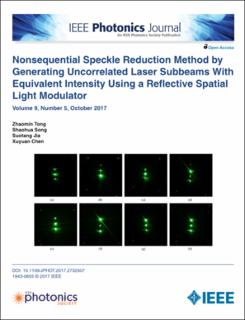| dc.contributor.author | Tong, Zhaomin | |
| dc.contributor.author | Song, Shaohua | |
| dc.contributor.author | Jia, Suotang | |
| dc.contributor.author | Chen, Xuyuan | |
| dc.date.accessioned | 2020-02-17T14:04:17Z | |
| dc.date.available | 2020-02-17T14:04:17Z | |
| dc.date.created | 2018-01-03T17:52:04Z | |
| dc.date.issued | 2017 | |
| dc.identifier.citation | IEEE Photonics Journal. 2017, 9 (5), 1-9. | nb_NO |
| dc.identifier.issn | 1943-0655 | |
| dc.identifier.uri | https://hdl.handle.net/11250/2642049 | |
| dc.description.abstract | Sequential speckle reduction methods demand the usage of fast modulators due to the short integration period of human eyes. Here, a nonsequential speckle reduction method by splitting one laser beam with short coherence length into uncorrelated laser subbeams(LSBs)isreported.Inordertorealizethemostefficientspecklereduction,withthe help of a polarization beam splitter, we have programmed a reflective spatial light modulator to make the LSBs intensities equivalent. Three uncorrelated LSBs with equivalent light intensity are designed to demonstrate this idea; the speckle contrast ratio is reduced to 0.55, which closes to the expected value of 0.58. This nonsequential speckle reduction method has no requirement of the modulators speed; thus, it has obvious merit comparing with the sequential speckle reduction methods. | nb_NO |
| dc.language.iso | eng | nb_NO |
| dc.title | Nonsequential Speckle Reduction Method by Generating Uncorrelated Laser Subbeams with Equivalent Intensity Using a Reflective Spatial Light Modulator | nb_NO |
| dc.type | Journal article | nb_NO |
| dc.type | Peer reviewed | nb_NO |
| dc.description.version | publishedVersion | nb_NO |
| dc.rights.holder | (c) 2017 IEEE | nb_NO |
| dc.source.pagenumber | 1-9 | nb_NO |
| dc.source.volume | 9 | nb_NO |
| dc.source.journal | IEEE Photonics Journal | nb_NO |
| dc.source.issue | 5 | nb_NO |
| dc.identifier.doi | 10.1109/JPHOT.2017.2732507 | |
| dc.identifier.cristin | 1535242 | |
| cristin.unitcode | 222,58,4,0 | |
| cristin.unitname | Institutt for mikrosystemer | |
| cristin.ispublished | true | |
| cristin.fulltext | original | |
| cristin.qualitycode | 1 | |
